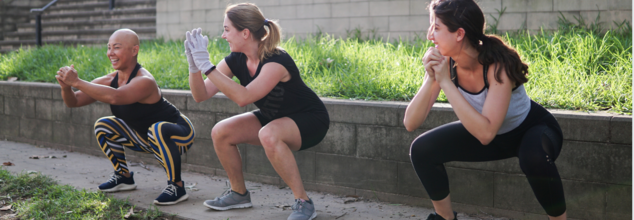- Health Conditions A-Z
- Health & Wellness
- Nutrition
- Fitness
- Health News
- Ayurveda
- Videos
- Medicine A-Z
- Parenting
- Web Stories
This Squat Variation Could Help Reverse The Effects Of Sitting All Day

Image Credit: Canva
If you’ve spent hours hunched over a desk or sprawled on a couch, you’re not alone. Modern sedentary lifestyles often leave us with tight hips, weak lower body muscles, and poor posture. But what if one simple exercise could counteract these effects? Enter the humble squat — a powerhouse movement capable of reversing the toll that prolonged sitting takes on your body. Among the many variations, a deep squat, commonly known as the "Asian squat," has become popular for its holistic benefits.
A squat is much more than just a lower-body exercise; it's a movement pattern deeply rooted in human biomechanics. From standing up from a chair to bending down to pick something off the floor, squatting mimics functional actions that are part of daily life. But unlike the limited range of motion associated with sitting, squatting engages multiple muscle groups and joints, including your hips, knees, ankles, quads, glutes, and calves.
Physiotherapists say squatting is the foundation of mobility and strength, especially as we age. Squats challenge balance, coordination, and mobility. They are necessary for everything from standing up to maintaining lower-body strength.
Why Sitting All Day Wreaks Havoc on Your Body?
Prolonged periods of sitting will increase muscle imbalance, stiff joints, and reduced flexibility. Your hip flexors become tight, your glutes become inactive, and slouching at the shoulders will affect your posture. Eventually, this will lead to chronic back pain and other musculoskeletal problems. Deep squats can serve as a counter-effect by loosening tight hip flexors, strengthening the core, and improving lower body stability.
How Deep Squat Is Beneficial?
Compared to the average gym squats, the deep squat focuses on range of motion and joint health. To perform a deep squat:
1. Stand with your feet a little wider than hip-width apart, toes angled out.
2. Chest upright and core engaged.
3. Lower your hips as far as your mobility allows to get the thighs below parallel to the floor.
4. Squat with the position held for a long time, balanced and heels on the ground.
This squat variation builds strength in addition to developing flexibility in your hips and ankles. A deep squat is one of the most natural resting positions that a human body assumes. Many cultures have the habit of adopting it as a way of daily life to eat, rest, or socialize.
Customizing Squat As Per Your Body
Everybody's squat is going to look different. It's about hip anatomy, femur length, and just how comfortable your body feels when you put it in certain foot positions, width, and angles.
If balance or ankle mobility is a concern, try the following:
Heel Raise: Place wedges, plates, or books under your heels to elevate them and make it easier to squat deeper.
Add a Counterbalance: Stand holding a light dumbbell or kettlebell in front of you for more balance.
Provide Support: Lower yourself into a squat while having support from an immovable object such as a chair or a wall.
If you’re new to squats, start with bodyweight squats to build strength and confidence. Gradually incorporate variations like goblet squats, split squats, and single-leg squats to challenge your muscles further. For those aiming to add intensity, weighted squats with barbells or kettlebells can enhance muscle growth and endurance.
Long-Term Benefits of Squatting
It provides many benefits, other than aesthetically appealing, such as better strength of the lower limbs, better posture, increased flexibility, and low chances of injury. The most significant advantage is probably maintaining functional independence into old age. Experts point out that a good lower body strength and mobility are crucial to a long life. Squats make you active, thereby reducing your chances of falls and injuries.
Common Challenges
Has difficulty with depth or coordination? Don't be discouraged. Everyone faces their limitations. Constricting hips, weak ankles, or simply poor balance might limit movement for some. Mobility exercises can address these challenges through ankle stretches or hip openers; practice regularly, and remember, change is slow. Keep an eye on form and control and hold the weight lightly.
You don't need fancy gear or a membership to a gym to incorporate squats into your daily routine. Start with three sets of 10-15 bodyweight squats a day, increase in frequency and intensity as you move forward, and do these squats as part of your warm-up, cool-down, or take them between work to counteract sitting.
So the next time you’re tempted to sink into your chair for hours on end, think about how a few deep squats can reset your body and revitalize your health.
Morning vs Night Workouts: What Experts Say About the Best Time to Exercise

Credits: GEMINI
If you have made exercise a regular part of your life, you have probably wondered when the ideal time to work out really is. Should you lace up your shoes first thing in the morning, hit the gym after work, or mix it up depending on your schedule?
According to the American Heart Association, adults should aim for at least 150 minutes of moderate aerobic exercise or 75 minutes of vigorous activity each week, ideally split across several days. Adding resistance or strength training three times a week can provide even greater benefits. But what do fitness experts say about the best time to get moving?
Should I Work Out in the Morning or at Night?
Both morning and evening workouts come with their own advantages, but what matters most is consistency. The best workout time is simply the one that fits into your daily routine and keeps you moving regularly.
The Centers for Disease Control and Prevention (CDC) also recommends getting 150 minutes of aerobic exercise per week—activities like brisk walking, cycling, or jogging all count. It’s more effective to work out four evenings a week than to squeeze in only two early morning sessions.
Working Out in the Morning
Exercising early has a clear advantage, you can get it done before the rest of the day begins. Research also suggests that morning workouts can improve sleep patterns, regulate mood, and even support weight management.
Boosts Your Mood
Exercise releases endorphins, the body’s natural “feel-good” chemicals. Studies show that even short sessions of regular physical activity can lift your mood and lower cortisol, the stress hormone. Starting the day with lower stress levels can help you feel more focused and positive throughout the day.
Improves Sleep Quality
Morning exercisers often enjoy deeper, more restful sleep. One study found that those who worked out early tended to fall asleep faster, spend more time in deep sleep, and wake up less during the night.
May Lower Blood Pressure
Morning workouts can help stabilize blood pressure, particularly in women. Research suggests that women who exercised early in the day experienced lower post-exercise blood pressure, while men saw similar results when exercising in the afternoon.
Might Help You Lose Weight
Timing might play a role in how your body responds to exercise. One study found that people who worked out before noon lost more weight than those who exercised later in the day. Early exercisers were also more active overall, taking more daily steps. However, more research is needed to confirm these findings.
Downsides Of Morning Workout
Despite the perks, morning workouts aren’t without drawbacks:
- Higher injury risk: Your body temperature is lowest right after waking up, which means less blood flow and muscle flexibility. This can increase your risk of strains or sprains. A proper warm-up can help prevent this.
- Low energy: Exercising on an empty stomach can make you feel weak or tired. Eating a small, protein-rich snack the night before or before your workout can help.
Working Out in the Afternoon or at Night
While early workouts offer plenty of advantages, exercising later in the day has its own set of benefits that may suit your body and lifestyle better.
Benefits Of Working Out in the Afternoon or at Night
- Better sleep quality: Moderate evening workouts can promote deeper, more restorative sleep and improve mental clarity and energy levels.
- Increased strength: Muscles follow a natural circadian rhythm, peaking in strength and flexibility in the afternoon or evening. This can enhance performance and help you lift heavier or move more efficiently.
- Stress relief: Evening workouts can be an excellent way to unwind after a long day. Physical activity triggers endorphins that improve mood and reduce tension.
- Social motivation: Friends and family are often more available later in the day, making evening workouts a good opportunity for shared fitness goals and accountability.
- Lower injury risk: Your body temperature is naturally higher in the evening, which helps muscles warm up faster and reduces stiffness.
Downsides Of Working Out in the Afternoon or at Night
- Sleep disruption: High-intensity exercise close to bedtime can leave you too energized to fall asleep easily. If you prefer nighttime workouts, stick to moderate activities like yoga or a brisk walk.
- Limited class options: Some gyms or studios may offer more morning classes than evening ones.
- Inconsistency: Evening schedules can get crowded with social plans or work commitments, making it harder to maintain a regular exercise routine.
How To Create a Workout Routine?
No matter the time of day, staying consistent is what truly makes the difference. Creating a set routine can help you build momentum and stick to your fitness goals long-term.
Morning and evening workouts both offer unique benefits and a few drawbacks. Some studies suggest morning exercise may deliver slightly better results overall, but the best time to work out is the time that fits your life. What counts is showing up for yourself and keeping the habit steady.
Long Walks Vs Several Short Walks? Study Reveals Which One Is Better For Your Health

(Credit-Canva)
Walking is said to be one of the best exercises. Not only is it an easy and accessible exercise, but it can be done anywhere and also does not need a lot of equipment. Many people aim for 10,000 steps a day as a sign of good health. But should you take one long walk, or multiple short ones? A new study has answered this question.
New research suggests that a single, longer walk each day is better for your heart than breaking up your steps into many short strolls, especially if you don't exercise regularly.
The study, published in Annals of Internal Medicine, found that walking for at least 15 minutes without stopping is ideal. This longer, steady pace, which is about 1,500 continuous steps gives your heart a much better workout.
Longer Vs Shorter Walks: Which is Better?
Researchers tracked the walking habits of over 33,500 adults in the UK who walked less than 8,000 steps a day. After tracking their health for eight years, the findings were clear:
Lower Heart Risk
People who consistently walked in longer, uninterrupted stretches had a lower risk of heart problems compared to those who only took short, quick bursts of steps.
Why Are Longer Walks Better For Health?
Even among the least active group (those walking under 5,000 steps daily), taking longer walks made a major difference. Their risk of heart disease and early death dropped significantly.
The researchers explain that most people focus only on the number of steps they take, but not the patterns. They suggests that even inactive people can boost heart health by changing their habits to walk for at least 10–15 minutes at a time.
Should People Focus More On How They Walk Or How Much?
Many people aim for 10,000 steps a day, but that number actually came from an old pedometer advertisement, not science. While experts agree more steps are generally good, this study emphasizes that how you walk matters more than just the total step count.
The researchers suggest that simple changes, like setting aside time specifically for a long walk, could make a big impact on heart health.
The NHS still recommends getting 150 minutes of moderate activity like brisk walking, each week, and ideally it should be spread out. For older adults, moving every day, even with light activity around the house, is key.
It's important to know that while the study shows a strong link between longer walks and better health, it doesn't definitively prove that walking directly causes the improvement.
However, health experts agree exercise is vital. They explain that you might find it hard at first, but it will get easier as your body adjusts. Even small improvements contribute to a healthy heart.
What Are Some Safety Tips for Walkers?
While walking is generally a safe activity, accidents can happen, especially if you like to walk alone. To stay safe while walking,
Be Visible
Wear bright, reflective clothing or carry a flashlight after dark or in dim light so drivers and others can easily spot you.
Stay Alert
Focus on your immediate surroundings; avoid distractions like your phone or headphones to always know what's happening around you, especially traffic.
Use Paths
Walk or bike only on marked paths, lanes, or sidewalks, and cross streets at designated crosswalks where vehicles are expecting pedestrians.
Donald Trump Health Update: First Hand Bruise, Now Swollen Ankle, Is The President Hiding A Health Crisis?

Credits: AFP/X
Donald Trump health has become a heated topic of debate and the concerns around his health has resurfaced after a photo from his Kuala Lumpur visit on Sunday, October 26, went viral. He was spotted with swollen ankles. The photo that went viral is from a meting of the Association of Southeast Asian Nations (ASEAN), which kicked off his six-day trip.
The pictures of his swollen ankle have flooded on social media and people are saying that his ankle is seen to be extremely swollen. As per experts, this happens due to chronic venous insufficiency, which is a condition Trump had earlier announced to be suffering from.

Chronic venous insufficiency occurs when the veins in the legs have trouble sending back to the heart. This causes blood to pool and creating high pressure. This is usually caused by damaged or weakened valves in the veins and is characterized by symptoms like leg swelling, aching, and heaviness, which improves with elevation. Risk factors include age, a history of deep vein thrombosis, and prolonged periods of sitting or standing.
However, Trump's latest physical test says something else. The White House physician Sean P Barbabella declared that the president "remains in exceptional health, exhibiting strong cardiovascular, pulmonary, neurological, and physical performance". Barbabella also stated that his "cardiac age was found to be approximately 14 years younger than his chronological age".
Trump's Legs Could Also Reveal That He Had A Stroke
As per a "Physical Therapist", who posts videos on Instagram by the username @epistemiccrisis with 74.2k followers, Trump also had his peroneal nerve paralyzed. He explains, "The deep branch of common peroneal nerve, which supplies a muscle known as the tibialis anterior, which blends your foot up toward your head when you walk. This is known as dorsiflexion. If this nerve is paralyzed, you would get a foot drop."
However, he notes that this can be easily remedied with a brace, called ankle foot orthosis or AFO. He said that the president was most likely wearing it as the outline of the posterior portion of "what looks like an AFO" could be seen through his pants.
Concerns On Trump's Health
Previously, the same "Physical Therapist" claimed that President Trump had a stroke. This is because he had difficulty walking in a straight line. In fact, a 2021 study published in journal Healthcare notes that stroke is a major cause of disability worldwide and balance impairments are common disabling factors in patients with stroke, which could lead to falls.
However, as per the official medical records of the president, no such strokes were mentioned. His medical report pronounced him in "excellent health". The examination was done at Walter Reed National Military Medical Center. The report also emphasized that Trump maintains a "demanding daily schedule without restriction". Not only that, the report has gone so far to declare Trump's cardiac age as 14 years younger than his actual age after an electrocardiogram.
© 2024 Bennett, Coleman & Company Limited

